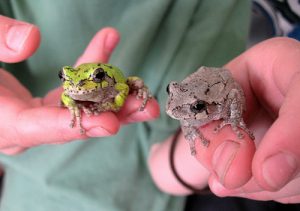Gray Treefrog Fact Sheet

The gray treefrog, sometimes called the Northern gray treefrog, is closely related to the Cope’s gray treefrog (Hyla chrysoscelis), with overlapping range and identical physical appearance. These two species are distinguishable based on variation in their calls. Hyla versicolor has a longer, slower call with a pulse rate that is about half as fast as the Cope’s treefrog. The gray treefrog is common to the northeast but has a distribution ranging from Texas across to northern Florida and up to Maine and New Brunswick. They prefer wooded habitats with trees and shrubs near to water sources.
Appearance: The gray treefrog varies in color from greenish-gray to gray-black depending on their background environment. They may have a light-colored spot underneath the eyes and their skin may have a bumpy texture. Gray treefrogs have a yellowish patch on the ventral side of their back legs which might only be visible when jumping or moving. These frogs are expert at camouflage and may have a mottled pattern resembling lichens, although they tend to be more greenish during the breeding season. Gray treefrogs are relatively small, ranging from 1.5 to 2 inches in length with a maximum length of about 2.5 inches.
Feeding: Adults gray treefrogs are insectivores, mostly hunting insects found in the understory of shrubs and trees. Adults are also opportunistic cannibals and may feed on smaller frogs if they are small enough to catch. Larvae graze on algae and other plant matter found within their pond.
Life History: Gray treefrogs typically emerge from their winter burrows sometime in April and breed in May. Males defend territory in trees and shrubs near water sources and will attract a female with their loud calls. After mating, the female will attach egg masses to plants near the surface of a water source. Each egg mass has between 30 and 40 eggs and females will lay about 1,800 eggs in total. The eggs will hatch after 3 to 7 days and tadpoles complete metamorphosis after 4 to 8 weeks.
Vocalization examples:
USGS Upper Midwest Environmental Sciences Center: Link to webpage
Connecticut Wildlife: Link to audio file
Sources and Additional Information:
USA Phenology Network, Observing Plants and Animals: Hyla versicolor, 16 February 2018.
Natural Resources Canada: Tetraploid Gray Treefrog (Hyla versicolor), 16 February 2018.
Connecticut Wildlife: Gray Treefrog. 20 February 2018.
Animal Diversity Web: Hyla versicolor, Gray Treefrog. 20 February 2018.
